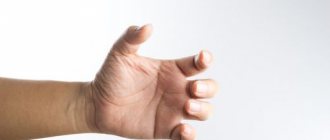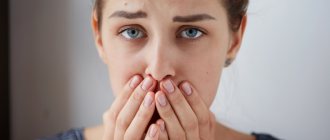Hemophobia is the fear of the sight of blood. This concept was first officially formulated by George Weinberg, a professor and psychiatrist in the USA. The name is associated with two terms - “hemo” - belonging to the blood, “phobos” - fear.
The main symptoms are:
- phobia when donating or transfusion;
- panic at the sight of wounds and scratches;
- fear of seeing violent scenes, images and films.
Phobic disorders put people, at the sight of red liquid, into a depressive state that brings hellish torment. A small drop of blood can make a person take involuntary postures and put him into a stupor. The disease is inexplicable and not understood, since there are no real reasons for its occurrence.
According to experts, blood phobia cannot be controlled and cannot be overcome due to weak willpower. Panic attacks involve reckless and stupid behavior. The patient, having reached a satisfactory state, cannot explain his behavior.
Hemophobia makes life difficult for a person and deprives him of medical procedures, such as blood transfusions, injections, surgical interventions, and going to the traumatology department. Fear constrains, and the patient does not promptly go to a medical institution for routine medical care. His inner world is filled with fear.
Causes of fear of blood
The onset of symptoms is noted in childhood. It appears much less frequently in adults. Since genetic predisposition has not been confirmed, there is an opinion that fear is transmitted from parents. This is due to the fact that they adopt the habits of adults.
Causes:
- traumatic event;
- unsuccessful surgery;
- death of a loved one;
- information from the media from the crime scene.
Overly impressionable people can become victims. One drop leads to associations of crime, death or cruelty.
The procedure for donating blood and treating a wound are postponed in some cases, as the doctor evaluates the harm and benefits in case of fear of hemophobia. One of the significant reasons for the emergence of a fear of blood is increased attention to negative experiences. “I’m afraid to donate blood from a vein” is a common phrase from patients. A person is constantly in anticipation of “bad things”, or is looking for non-existent illnesses in himself.
According to psychiatrists, the increase in the number of cases occurs during the period when abundant scenes of violence appeared on television. An anancaste person has her own opinion that an accident can happen to a person at any moment, and he bleeds to death.
Overcoming your fear, and, therefore, stopping being afraid of blood is the best medicine in treating the disease.
How to overcome fear - recommendations from psychologists at our clinic
It is worth noting that when various kinds of fears arise that are episodic in nature and do not “enslave” a person’s will, it is possible to try to cope with them on your own. Knowing how to overcome fear, it is quite possible to overcome it.
- Get together and do it. No matter how difficult life situations are, act without paying attention to the approaching fear. Anything you haven't done before or anything new can create uncertainty and fear. How you feel fear, weak or strong, is influenced by the strength of belief, which must be changed by action. Only by doing something will you drive away fear, but procrastination increases it. Accept that you are scared, accept the fear, but do it as you intended. Remember, long thoughts will not answer how to overcome fear; you just have to act! Believe in luck.
- What could be worse when it couldn't be worse? When you need to do something, but it’s scary, imagine the most negative turn of possible events. Believe me, this is much better than the unknown, which is called “the most devastating weapon of fear.” Only by understanding and finding the source of fear can you see that it is not scary. But fear is also a defensive reaction. Therefore, if, after calculating all the consequences of the most undesirable option in which events will develop, fear remains, then it is worth thinking about the need for these actions. Assess your own fear - if it is not groundless, then hear it by making the right decision.
- The decision has been made - carry it out. Get serious about doing something, giving yourself the determination not to deviate from what you have planned - there will be no fear, it will go away. Fear feeds on our doubts and insecurities. He “whispers” to the mind that everything will be bad, negative. When considering your actions and making a decision, always hope for a good ending. Do not allow negative thoughts, drive them away. Remember? The eyes are scared, but the hands continue to act. Without a doubt, make a decision by telling yourself that there is no turning back. Be decisive, and the task of how to overcome fear will no longer be unanswerable.
- Analysis of fear. Don’t ask the question of how to overcome fear, but analyze it. Fear refers to emotions that are stronger than logic. Even understanding the meaninglessness of fear, you can continue to be afraid. “Scroll” the entire course of events in your mind, overcome this feeling in your imagination, this technique will help you cope with it in reality - the model of events is fixed on the subconscious level. A technique based on self-hypnosis - visualization - is very effective.
- We train courage. Identify your own “core” fear. Then break it down into smaller fears that you can begin to overcome. Does not work? Again, break down any fear you have into small ones. Then, step by step, overcome them. Heroes know how to overcome fear. Be brave and you can become that hero.
- Increasing your own self-esteem is a good answer to the question of how to overcome fear. Think only well of yourself, even if your own self-esteem is overestimated. It has been noticed that people with high self-esteem, although somewhat biased, achieve more than those who evaluate themselves adequately.
- Belief in a higher power and a guarding angel. Fear goes away if you have faith that someone, very strong, cares and protects you.
- Feeling of love. There is no fear that love cannot overcome.
- Always smile. Only positive emotions can overcome fear, and negative ones make it stronger.
Knowing how to overcome fear will give you the strength to cope with it. But remember that a phobia requires the mandatory help of a psychotherapist. She is cunning and not to be trifled with.
Manifestations of hemophobia in humans
Fear of blood is expressed in varying degrees. Mild forms bring less fear. As for serious medical interventions, they are carried out under the strict supervision of a doctor. In some cases, patients avoid visiting medical offices and hospitals. Because they have a fear of seeing blood or losing their own. A panic attack can begin even if the patient sees a small amount of red liquid.
Signs of an attack:
- pale skin;
- cardiopalmus;
- trembling of the arms and legs occurs;
- frequent and intermittent breathing;
- shortness of breath or suffocation;
- increased blood pressure.
Often attacks occur not so much from the sight, but from the thought and sensation of the smell of blood. Sweating, nausea and chills increase. A person cannot stand on his feet and needs a horizontal body position. The chest is filled with discomfort and compression. Often attacks are accompanied by loss of consciousness, uncontrolled behavior and unreasonable actions.
Additional Information! A person suffering from hemophobia will not be able to take adequate action in the event of an accident. He is unable to treat the wound or stop the bleeding, as he will become a victim of paralyzing fear.
Hot topic
Trypanophobia is a common psychological disorder.
This is a pathological fear of pricks, needles, syringes and injections. According to a study published in 2012 by the medical journal Vaccine by scientists at the University of Toronto (Canada), two-thirds of children and a quarter of adults are fearful and tense about needles. From 5 to 10% of the world's population experiences severe fear and anxiety at the thought of a medical syringe. Urgency
Photo: IZVESTIA/Pavel Bednyakov
In an unhealthy body: the top 5 consequences of COVID-19 are named
The only way to avoid complications is vaccination
There is an opinion that trypanophobia directly depends on the historical factor in the provision of medical services. In countries where disposable syringes with thin needles appeared earlier (in particular, in the USA), there is less fear of injections than in countries where thick metal needles of reusable syringes have been used for a long time (for example, in Russia and post-Soviet states).
Those suffering from this phobia usually honestly admit that they are afraid of injections. However, talking about a sensitive topic is disgusting and unpleasant for them. Just the thought of the procedure makes you wince and causes a lot of suffering. Moreover, the closer the moment of vaccination, the more difficult it is to remain calm.
How to get rid of the fear of blood
Hemophobia is difficult to cure. Only a psychiatrist can provide effective treatment if the cause is a traumatic situation. The doctor reduces the level of its significance and develops the patient’s psychological stability.
There are 3 methods used to treat fear of blood:
- psychological;
- medicinal;
- independent.
If the issue of treating hemophobia is being decided, then it interferes with a healthy life and the situation is out of control. The best method of combating the disease is considered to be frequent contact with a frightening element. An example would be interns and first-year surgeons who, as a result of practical training, get used to the sight of blood and are not afraid of it. This is real practice that really works. But psychotherapeutic methods are more reliable.
Note! Before donating blood or other traumatic situations, the patient is recommended to inform the medical staff about his illness. They, in turn, will be able to provide timely help and psychological support. Since in an emergency situation the patient will not stop thinking about blood and will not be able to respond to words.
With the help of psychotherapy
An effective method in the fight against homophobia is CBT (cognitive behavioral therapy). The patient tunes in to a positive wave, under the guidance of a psychotherapist. Gradually develops and consolidates an attitude to overcome fear. The procedures include meditation and breathing exercises. They help the patient calm down before and after blood is taken.
Situational anxiety is relieved through relaxation. Resistance to a frightening object is developed through the use of special psychotherapeutic techniques. According to experts, this method activates the mechanism that is responsible for adaptation and causes addiction to the type of frightening factor, and blocks the feeling of fear. Psychoanalysis and hypnosis are also used.
Hypnosis can really help a patient develop adequate reactions to the sight of blood. The process is aimed at developing skills to manage emotions in a stressful situation. Hypnosuggestive treatment develops complete psychological stability. A person is not afraid of blood or its signs.
Hypnosis is considered the most effective treatment technique. Eliminates the causes and symptoms of fear. Numerous scientific researches and successes have been achieved with positive results thanks to hypnosis. Severe cases require medication intervention. The dosage is selected by the attending physician.
If you suffer from such an ailment as fear of blood, on our website you can answer for yourself the reasons for its occurrence. A home environment, silence and comfort contribute to a better disclosure of spiritual impulses to oneself. Virtual communication with professional psychologists will help you set priorities in life and it will become clear how to act in situations related to blood phobia.
Medication
Medicines begin to fight the disease if the disease progresses and becomes the development of other mental disorders.
In this case, the following is prescribed:
- antidepressants;
- tranquilizers;
- sedatives;
- sleeping pills.
Pharmaceutical drugs stabilize the psycho-emotional status and eliminate nervous tension. This treatment is carried out in short courses and is prescribed for severe sympathoadrenal crises.
Important!
You should not use or prescribe medications yourself. You should consult a doctor. Since all of the above drugs have contraindications.
On one's own
Often, patients are interested in how to stop being afraid of blood without drug intervention. In the treatment of hemophobia, self-medication is practiced. This method is meditation. A system of self-development and self-knowledge.
Has the following qualities:
- strengthens well-being;
- normalizes mental state;
- improves physical health.
A person conducting meditation sessions withdraws from the outside world for a while and concentrates his thinking on his problem. Most importantly, the patient will be able to do this himself. By repeating the same installation for several weeks, you can get rid of the problem. For example, a mantra with the words “I am not afraid of blood” will take root in the subconscious, and over time, healing will occur.
Phobias
Vomit
20634 01 November
IMPORTANT!
The information in this section cannot be used for self-diagnosis and self-treatment.
In case of pain or other exacerbation of the disease, diagnostic tests should be prescribed only by the attending physician. To make a diagnosis and properly prescribe treatment, you should contact your doctor. Phobias: causes, symptoms, diagnosis and treatment methods.
Definition
Phobias are an anxiety mental disorder in which a person is haunted by a constant feeling of unreasonable fear caused by certain types of objects, actions or circumstances. This is an absolutely irrational feeling, for which there is no basis, but at the same time all-encompassing and persistent. To date, more than 500 types of phobias have been described. The most common of these are social phobia and agoraphobia.
The vast majority of phobias are classified as mental disorders.
Translated from Greek, “phobia” means “fear, fear.” Natural fear protects a person in situations where he could be seriously harmed or even killed. Every healthy person experiences natural fear from time to time, which is a protective mechanism of the self-preservation instinct. This feeling of fear is completely conscious and controlled by common sense and logic. But when a person begins to fear something that does not pose a real or even potential threat to him, we are already talking about a phobia.
People with phobias may be afraid of thunderstorms, blood, flying on airplanes, crossing the street, being in a confined space - things that most people are completely calm about. Sometimes they experience fear of completely harmless things, such as the dark, water, and even the starry sky.
A person prone to a phobia develops panic, and in the future he feels even greater fear of a repetition of a particular situation, trying to avoid circumstances and objects that cause panic horror.
Emotionally sensitive people with a rich imagination and/or a weak nervous system are prone to phobias. It has been established that for the most part, attacks of severe fear are provoked by one single case when a dangerous (or imaginary dangerous) situation has arisen. Having experienced it once, people try in every possible way to prevent it from happening again.
As a result of the cultivation of negative memories and images, a phobia develops.
Phobias, as a type of neurotic disorder, are a widespread phenomenon, occurring in 5-12% of the population. Most phobic disorders, except social phobias, are more common in women.
Causes of phobias
There are several groups of factors that can influence the development of phobias.
Genetic
. The influence of genetic factors averages 35-45%, and only for agoraphobia, which is the most inherited form of phobia, this figure increases to 61%.
Biochemical
. In some cases, patients with phobias showed increased concentrations of inflammatory markers, including cytokines and C-reactive protein, which may be associated with an activation of the stress response of central and peripheral immune cells. Social anxiety is further characterized by neuroendocrine changes (increased cortisol levels and decreased testosterone). In addition, the use of psychoactive substances, alcohol and drugs can contribute to the development of pathological fears.
Psychological
. Tendency to experience negative emotions, fixation on negative events, childhood and adolescent psychological trauma. People with phobic disorders often experience timidity, excessive caution, increased impressionability, and indecisiveness even in childhood.
High levels of social anxiety are associated with lack of social skills and negative self-esteem.
Classification of the disease
According to the International Statistical Classification of Diseases and Related Health Problems, anxiety-phobic disorders are coded F40 (F40.00 without panic disorder, F40.01 with panic disorder).
Phobias that doctors encounter include:
- Agoraphobia is the fear of any situations from which there is no immediate way to get out and return to a safe place. And also the fear that timely help will not be available. This type of phobia manifests itself in fear of crowds, public places, unaccompanied travel, and movement outside the home.
- Social phobias are a pronounced fear of being the center of attention of strangers. Characteristic of those who experience anxiety about how they appear in the eyes of others. A person worries that the words he speaks will sound stupid and inappropriate, that his appearance is repulsive, and that no one needs him. This type of phobia manifests itself in a wide variety of everyday situations.
- Specific (simple or isolated) phobias are all other phobias that represent fear and anxiety about a specific situation or object. A huge number of phobias have been described, the names of which, as a rule, are formed using the roots of Greek words that denote the object of fear. The most famous and common are:
- nosophobia - fear of getting a serious illness: cardiophobia, cancerophobia, etc.;
- zoophobia – a pathological fear of certain types of animals, for example, snakes, spiders, rats or dogs;
- fear of natural phenomena (for example, hurricanes, heavy rains);
- fear of blood, injections, injuries (eg, needles, medical procedures);
- fear of situations, including:
- claustrophobia - fear of closed spaces;
- phagophobia - fear of choking on food;
- gypsophobia - fear of heights;
- oxyphobia - fear of sharp objects;
- Aerophobia - fear of flying in aircraft.
Symptoms of phobias
The main symptom of a phobia attack is the sudden onset of extreme anxiety, which very quickly takes the form of panic fear.
Common symptoms for all types of phobias are:
- Autonomic symptoms:
- strong and rapid heartbeat;
- sweating;
- shaking or tremor;
- dry mouth (but not due to medications or dehydration).
- difficulty breathing;
- feeling of suffocation;
- chest discomfort or pain.
- dizziness, fainting;
- a feeling of unreality of surrounding objects (derealization);
- fear of loss of control over the situation and insanity;
- fear of dying.
- hot flashes or chills;
- numbness or tingling sensation in the extremities.
Social phobias additionally cause the following symptoms:
- skin redness;
- fear of vomiting;
- urge or fear of urination/defecation.
If a person notices two or more of the following symptoms in himself or his loved ones, there is a need to seek specialized help:
- unexplained strong fear, panic, anxiety for six months;
- the realization that such strong fear has no real reason;
- purposeful avoidance of places, situations, objects, objects due to severe fear;
- avoidance brings discomfort into daily life and interferes with normal functioning.
The causelessness and groundlessness of fear only increases the level of anxiety.
Diagnosis of phobias
At the initial examination, the doctor carefully collects a life history and listens carefully to the patient, conducts a physical examination (external examination, measurement of height, body weight, assesses the level of physical development, integrity of the patient’s skin) in order to determine the somatic status. To make a reliable diagnosis, the patient's condition must not be explained by other disorders. Otherwise, additional examination is necessary.
Diagnosis of phobias requires confidential contact between the psychotherapist and the patient.
During the conversation, the specialist asks leading questions taking into account what the patient is telling. During such communication, it is possible to determine the presence of specific phobias, and sometimes the reason that provoked their appearance.
In his medical practice, each psychotherapist uses various clinical diagnostic scales and tests, with the help of which it is possible to distribute fears, identify the dominant ones among them, and establish the degree of fear and anxiety.
The main goal of laboratory and instrumental examinations is to exclude somatic diseases that may cause symptoms similar to those of an anxiety-phobic disorder. For this, the following studies are prescribed:
- general (clinical) blood test;
Possible causes of hemophobia
Childhood trauma, accompanied by pain and bleeding, can cause the development of hemophobia.
Fear of blood develops under the influence of factors that influence a person’s autonomic nervous system, as well as his psyche.
Congenital causes are considered separately, namely:
- hereditary predisposition - if at least one of the parents has a similar phobia, then there is a high chance of it occurring in their descendants;
- congenital mental pathologies as a consequence of intrauterine development disorders;
- evolutionary memory - in ancient times, people were afraid of even a small shed of blood, because this phenomenon could lead to serious consequences and even death;
- deviations in the process of formation of the ANS during the prenatal period.
It is also worth considering the reasons that are acquired in nature, those that appeared during the life of the individual:
- severe fear in childhood after a physical injury, for example, the baby could break his nose, while feeling severe pain, which was combined with profuse bleeding;
- improper upbringing of parents (intimidation of a child in order to protect him) - the mother says “don’t run so fast, otherwise you will fall, get hurt, a lot of blood will flow out, and you will die”;
- unsuccessful communication with the manipulation nurse, for example, if it was impossible to take venous blood for analysis the first time;
- severe injury in which a lot of blood was lost - there may be fear for life;
- influence of the media - watching crime programs, bloody films has an impact on sensitive people, which is manifested by hemophobia;
- may arise due to fear of contracting an incurable disease through the blood.
Characteristic manifestations
Many people do not realize that they have a fear of the sight of blood. They learn about this already during direct contact with the object of fear. And it’s really bad if this moment coincides with the need to act as a donor or provide first aid for an open fracture. After all, then such a person is of little use. It may include the following symptoms:
- severe panic;
- acute feeling of anxiety;
- nausea occurs, vomiting is possible;
- severe dizziness;
- tachycardia;
- pressure surges manifested by tinnitus and severe headaches;
- pale skin;
- tremor of the limbs;
- fainting.
Causes and symptoms
Experts cannot name the only reason that causes phobias, but, as a rule, this is an echo of negative childhood experiences. However, an adult can also find himself in a situation that leaves a significant imprint on the psyche. Often people simply forget that bad things happened to them before, but for some adults they emerge in the subconscious - the connection between the incident and the emotions experienced is deposited in it.
There is an opinion that obsessive fear can be inherited and “triggered” after stress. A heightened instinct of self-preservation also contributes to the emergence of phobias.
As for the signs of this mental disorder, they are as follows:
1. The desire to avoid the situation causing the phobia by any means.
2. Feeling of a lump in the throat, inability to breathe.
3. The whole body is shaking.
4. Rapid heartbeat - the heart literally “breaks out” of the chest.
5. The appearance of sticky cold sweat.
6. Weakness in the body, it stops listening, immobilization.
7. Terrible fear.
8. The stomach hurts, there may be loose stools, vomiting.
What is the danger?
Like any other fear, hematophobia or hemophobia (both names are used) generally cannot harm a person who is afraid of the sight of blood.
But powerful fear manifests itself not only at the sight of one’s own bloody clothes or a drop of blood from a cut finger. Exactly the same panic grips a hemophobe when, for example, he witnesses another person being injured. In the second case, there are escape routes: run away or turn away, but you won’t be able to get away from your blood, so the experience will be brighter, stronger and more painful. Doctors have already had to deal with situations where they had to provide assistance not only to the victims, but also to random passers-by, among whom were hemophobes.
Hemophobia does not select its “victims” based on age or gender. The sight of blood can make children and adults, men and women, sick; fear does not depend on the state of health and well-being.










